REEL RETRO CINEMA: Reb Brown’s Captain America movie aired for the first time 45 YEARS AGO, on Jan. 19, 1979, on CBS…

—
UPDATED 1/19/24: REEL RETRO CINEMA’s Rob Kelly gives you an UP-CLOSE LOOK at the Star-Spangled Avenger’s first standalone movie, which 45 years ago followed his ‘60s cartoon and ‘40s serial. This first ran in 2021 but it holds up just as well today. Dig it. — Dan
—
By ROB KELLY
Over the years in REEL RETRO CINEMA, we’ve discussed the various Marvel superheroes that made their way onto the small screen: Spider-Man, Dr. Strange, and The Incredible Hulk. But there’s one name missing from that fantastic four: the Sentinel of Liberty, Captain America.
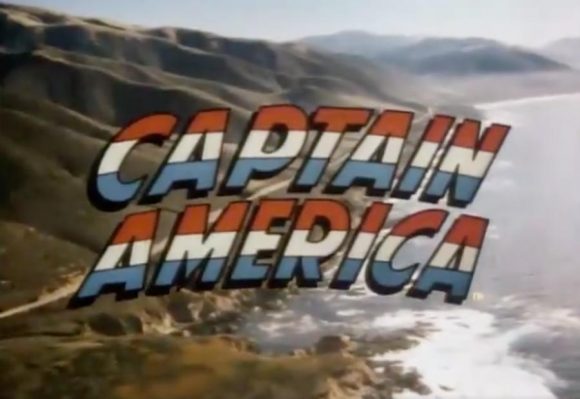
Considering how relatively budget-friendly Cap as a character is when it comes to live action, it seems strange that he would have made it to TV after his fellow members of the Marvel Universe. Perhaps TV producers wanted to get as far away from the Watergate Era as possible before trying such an unapologetically patriotic character. Or, with Star Wars exploding onto the pop culture scene with its upbeat, optimistic flavor – not to mention the continued popularity of Evel Knievel — they sensed the tide was turning, and people would really go for a super-powered guy dressed in red, white, and blue punching out baddies.
Directed by TV veteran Rod Holcomb (ER, The Six Million Dollar Man), 1979’s Captain America takes some of the basic elements of the comic book legend but updates them to modern day. Ex-Marine Steve Rogers, played by massive hunk of beef Reb Brown (Yor, Hunter From The Future, The Sword and the Sorcerer) is not a soldier in World War II era-America; rather, he’s a van-driving, soft-spoken, rather sensitive soul that belies his massive frame.
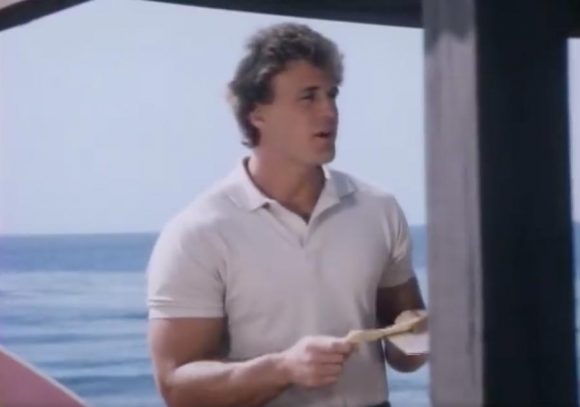
Steve keeps getting letters from a Dr. Simon Mills (Len Birman, who voiced Hercules in the 1960s Thor cartoon), but ignores them. Finally, he goes to see Mills, who explains that Steve’s father developed an experimental formula called FLAG (Full Latent Ability Gain — “S.H.I.E.L.D” it ain’t), which gives people accelerated, almost super-human, abilities. Steve’s Dad had a reputation for always fighting for the Little Guy, so much so that he was known as “Captain America.” Now Steve understands why, when his Dad died, he got a letter of condolence from the President himself!
After a friend of Steve’s is murdered by some crooks who want to get their hands on Does It Matter, Steve is followed by those very crooks, who think he knows more than he does (had they met this version of Steve Rogers before, I think him knowing too much would not be a major concern). Steve is almost killed by the bad guys (led by an “industrialist” named Lou Brackett, played by the legendarily gravel-voiced and lantern-jawed Steve Forrest—The Longest Day, Spies Like Us), so Mills and his assistant, Dr. Wendy Day (Heather Menzies; Logan’s Run, The Sound of Music) are forced to give Rogers the FLAG formula to save his life. I say forced, but to this point Mills has been so gung-ho about FLAG you get the sense he was really waiting for a moment just like this.
In one of the movie’s best scenes, Steve and Dr. Mills talk on the beach about Steve’s newfound abilities, and he is (rightly) worried about all this new power he has, and how he has to keep it under tight control, lest some innocent person gets hurt. It’s the proverbial “With great power, comes great responsibility” scene, probably the biggest Marvel Comics touch of the whole effort.
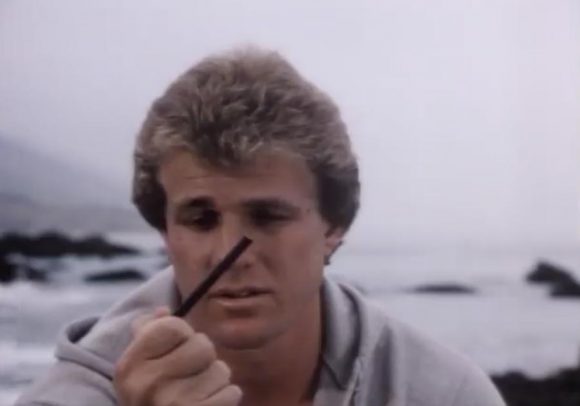
But all that 1970s EST/Alan Alda/Sensitive Guy self-reflection stuff is quickly shunted aside when Mills give Steve something we all came to see — namely, a red, white, and blue rocket-powered super-awesome stunt cycle! In an extended sequence, Steve goes on a joyride on his new toy, and the Captain America theme music swells. The bad guys try and take Steve out again, but he escapes.
Brackett then tries to manipulate the daughter of the man they killed, so he can get a hold of No, It Doesn’t Matter. Brackett then moves forward with his plan, which is to build a neutron bomb so he can blow up everyone in Phoenix, Arizona, where a massive gold mine resides. Brackett then kidnaps Dr. Day — whom Steve has taken a liking to — and that forces Steve to suit up as the new Captain America to rescue her and stop the bomb from going off.
This particular Captain America seems to really enjoy beating the crap out of bad guys (can’t blame him). He throws them around, hits them with his boss not-at-all-plastic shield, even covering them in oil with a big smile on his face.
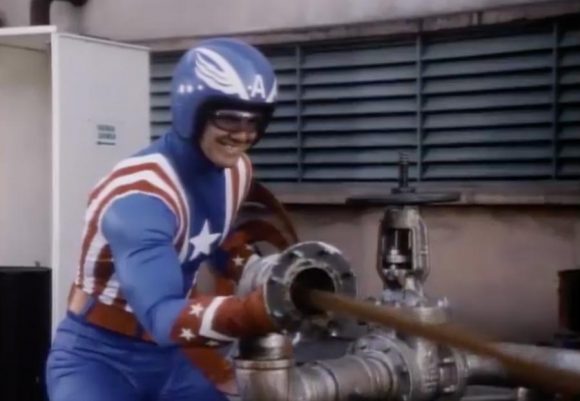
The film ends with another chase on the Cap-Cycle, and Brackett’s plan is foiled, even after he hooks the bomb up to his own chest (who is he, Tony Stark?). After Dr. Day is rescued, Steve then decides to commit to being Captain America, keeping the country safe from any and all who would threaten it. The End.
I remember watching Captain America when it originally aired (January 19, 1979) and coming away mildly entertained. I liked the stunt cycle, of course, and the (helmet aside) fairly faithful representation of the costume. But with the benefit of hindsight and many good and bad Captain America movies later, I can see this movie for what it was — an earnest, if feeble, attempt at making superheroes “palatable” for a modern TV audience.
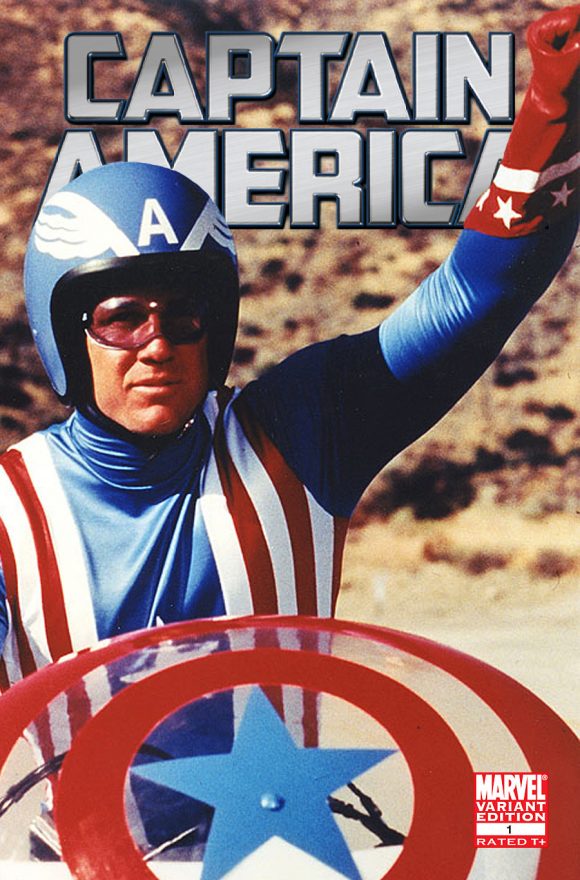
Variant cover for one of the gazillion Captain America #1 issues of the last several years.
The main problem is the pacing. For a movie that is barely longer than 90 minutes, Captain America is glacially slow. We spend way too much time watching Steve Rogers drive around in his Chevy Van, and that’s not all right with me. Reb Brown’s Steve is such a quiet, mellow dude, that he practically has to be dragged into the action. He’d rather just, you know, sit on the beach and draw, you dig?
And when that sensitivity is actually a plus — the aforementioned scene on the beach — it’s put into the wrong spot in the movie. After Steve gets the formula, we want to see him become Captain America and start doing cool stuff, not whine to Dr. Mills. As I said, I like that scene, but it should have come at the end of the movie, not squat in the middle, interrupting whatever narrative momentum they had going.
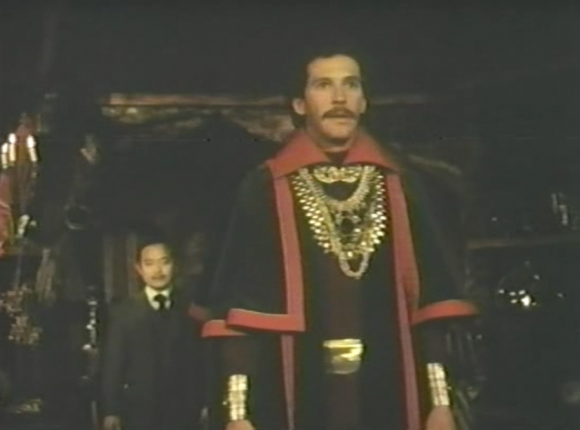
Peter Hooten as Dr. Strange
Steve Forrest’s Lou Brackett is also a little too dull as a super-villain. I realize that, outside of the 1978 Dr. Strange movie, none of these Marvel TV adaptations had colorful villains, mostly because the producers just didn’t think audiences could handle these things being too comic book-y. But a guy who wants to steal a bunch of gold — Goldfinger notwithstanding — just isn’t that interesting, nor does it really tie into the theme of America needing a champion from those who would attempt to bring it down. Luckily, Universal would realize their mistake when it came to another Captain America TV movie and significantly upgrade their villain (but that’s a REEL RETRO CINEMA column for another day).
Considering how heavily Captain America leans into the whole Evel Knievel thing, it’s amazing to me that more (any?) merch wasn’t produced to tie in with this movie. There have always been Captain America toys, mostly from Mego, but, I dunno, it seems like a whole line of Cap cars and stunt toys could have been successfully marketed off the back of this movie. Then again, Mego never even did a Dr. Strange doll, and he got his own movie, so maybe these things weren’t the potential cash cows I imagine.
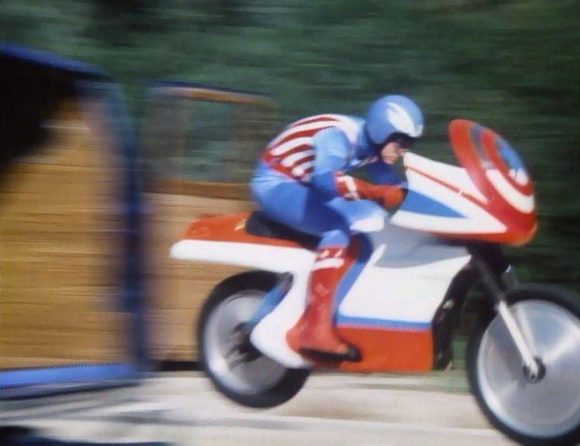
Is Captain America “good”? Not really. There’s not enough Cap action and most of the characters are too forgettable. But like a lot of these Marvel TV adaptations, its heart is in the right place and it’s mostly on par with the other movies of the time. Instead of feature-length movies, maybe Cap would have benefited from a more tightly paced one-hour weekly series.
Still, I would have killed for this Captain America to take me on a ride on his stunt cycle.
—
Rob Kelly is a podcaster and pop culture historian. He is the host/co-host of several shows on The Fire and Water Podcast Network, including Aquaman and Firestorm: The Fire and Water Podcast, Fade Out, TreasuryCast, Superman Movie Minute and Pod Dylan.
—
MORE
— Meet REB BROWN: Bronze Age TV’s CAPTAIN AMERICA. Click here.
— REEL RETRO CINEMA: 1944’s CAPTAIN AMERICA Serial. Click here.

January 19, 2021
I have a real soft spot for these movies, as you well know, Rob, so while I acknowledge their flaws, I tend to overlook them in a lot of ways. As expected, you have given them the fair and balanced review, and that’s all I could ask. Great read!!!
January 19, 2021
I think of Dr. Simon Mills as being very much the “Oscar Goldman” of this Six Million Dollar Man inspired Cap film. Although Steve Austin isn’t a bad template when adapting Cap to 70s TV. I remember being astonished when I saw the commercial for this literally a few minutes before it was going to air. Loved it at the time. Oh, and Len Birman … he’s not just Hercules. He’s the voice of Rocket Robin Hood.
January 19, 2021
I always thought Marvel sold out these characters back in the 70’s, CGI not withstanding, limited budgets, etc. Hulk was the best of the 70’s bunch. Even the 90’s Cap was hard to watch. Of course, I stayed up late to watch the 1940’s Cap Serials, full of action, etc. I am so happy Marvel took these back and weaved a wonder storyline for the past 12 years. Love to see more WWII Cap adventures with Chris Evans.
January 19, 2021
I am giving away my age by saying this, but….great “Chevy Van” joke, Rob.
I saw this movie as a kid, and from the first few minutes felt let down. It made me not want to watch any other ‘adaptations’ of Marvel characters, and annoyed me that the details of the heroes were changed for no good reason.
It’s like taking Sherlock Holmes and making him a football player, with his girlfriend, cheerleader Jane Watson, who stumble across cases in between home games. Taking what is essential to a character, details that define them, and throwing them away for who knows, just annoys the hell out of me.
January 19, 2021
@Bryan–Tee hee. Thank you, fellow oldster!
January 19, 2021
I read somewhere that the California Highway Patrol (CHiPS) mandated that Cap wear a motorcycle helmet during the cycle sequences. Art Dept tried different ways to approach it but in the end, decided on the “helmet is the mask” scenario.
January 19, 2022
“…even covering them in oil with a big smile on his face.”
“oil”
January 20, 2022
I enjoyed these when they came on. I knew it was a bit cheesy, but it was all we had.
Did Steve Rogers do art in the comics first or on TV? I knew he was doing it in the Stern/Byrne years but wasn’t sure if that was from an earlier period.
May 4, 2024
As best as I can tell they happened at around the same time. The first time I can see reference to Steve being an artist was an issue from 1979, the same year the movie came out. It’s possible there was previous mention of him being an artist in the comics before then and I just didn’t make a note of it.
January 22, 2023
We got the DVD of the two TV movies a while back and I was surprised how good they really were! The network could have done a couple of these a year for a few years and it would have worked out pretty well1 Oh, and I got to meet Reb Brown a few years after we saw the movies. He is still in amazing shape and was a nice fellow who seemed very modest about his career and how fortunate he’s been.
January 19, 2024
“I liked the stunt cycle, of course, and the (helmet aside) fairly faithful representation of the costume. ”
FAIRLY FAITHFUL? What costume did you grow up with?
January 20, 2024
I never understood why they had Steve Rogers in a costume that was far from comic accurate throughout the movie, only to put him in a more accurate costume in the last three minutes of the movie. Aside from that, I enjoyed the movie as a kid although it was hard to overlook the plastic shield.